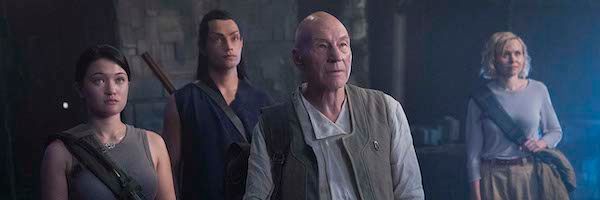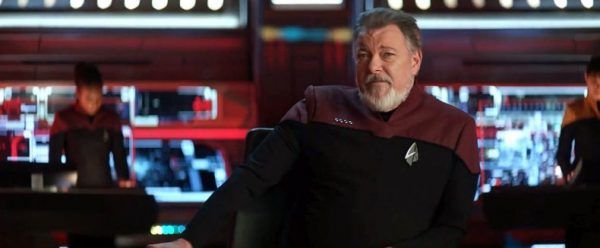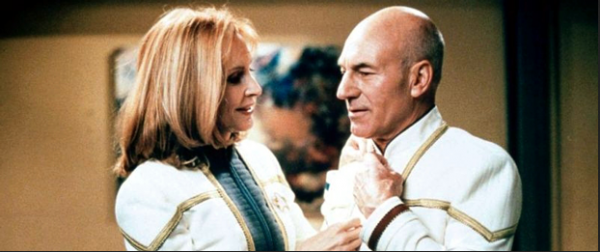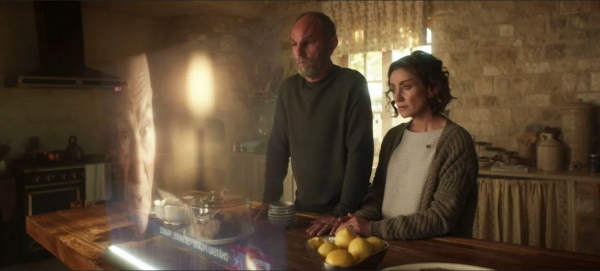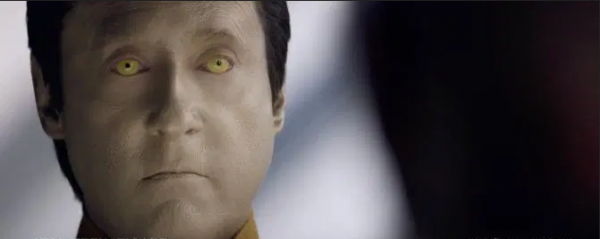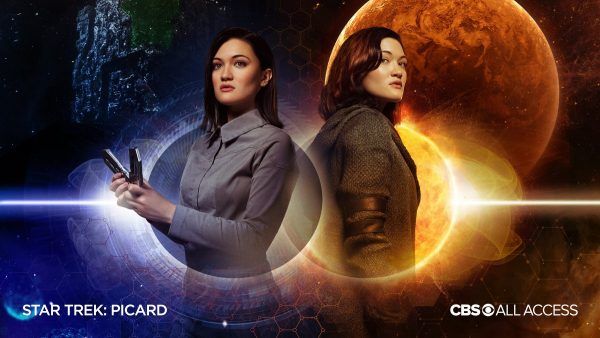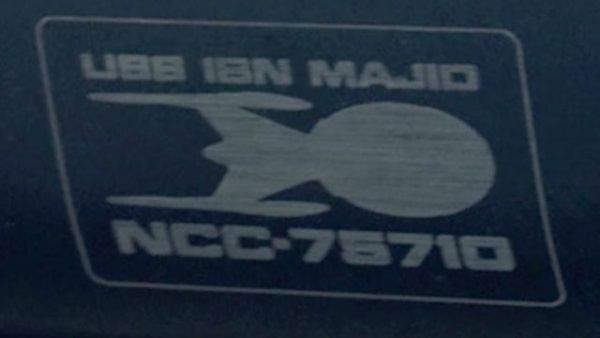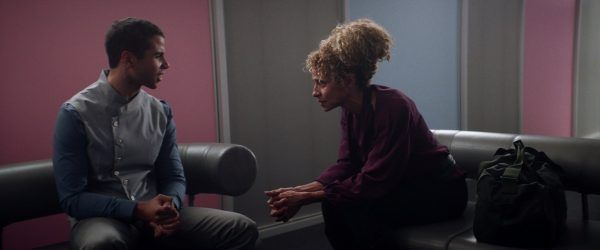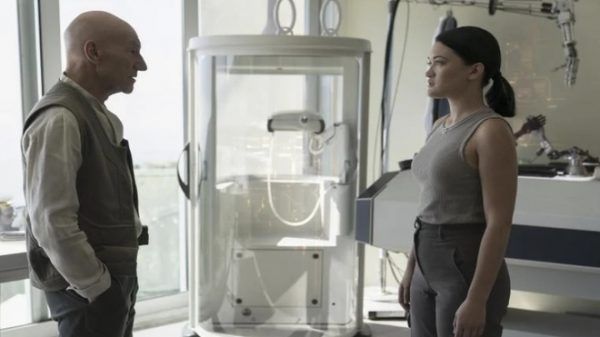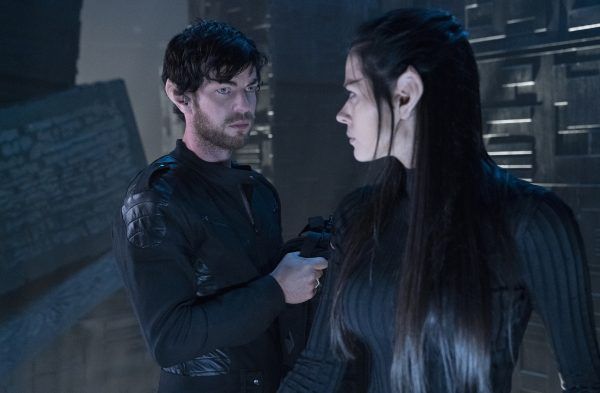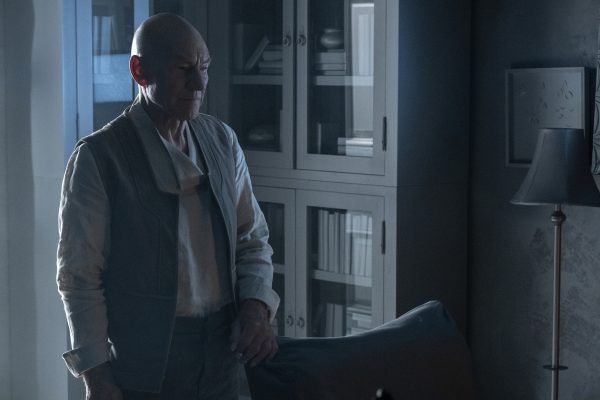Spoilers ahead.
"Et in Arcadia Ego," the title for the two-part finale of Star Trek: Picard's epic first season, translates to "even in Arcadia, there am I." The common interpretation of the phrase is that "I" refers to Death, and that "Arcadia" is a version of paradise. So a more apt contextual translation might be, "even in paradise, there is Death," a phrase that felt ominous and mysterious going into the Picard finale, but now makes a sort of bittersweet sense. In "Et in Arcadia Ego, Part 2," the erstwhile Captain Jean-Luc Picard (Patrick Stewart) sacrifices himself in order to save all life in the universe, both synthetic and organic, entering willingly into death in order to achieve his vision of peaceful coexistence. Death, for paradise.
There are other interpretations of the title, of course, including how the utopian Coppelius Station opened a portal to literal universal destruction, or how Data (Brent Spiner) finally achieved his ultimate wish of becoming human by embracing -- and even requesting -- his own mortality. It's a question with several possible answers, and one of many which was answered, more or less, by the end of Picard's first season. We now know the impetus for the synthetic attack on Mars, the purpose of the Admonition, and even what the show's hauntingly cryptic opening credits sequence really means (anyone who called "Picard is going to become a synthetic" early on, well done).
However, no Star Trek series has ever definitively answered every question that it has raised, nor should it. After all, one of the great joys of watching Star Trek is in how it often requires its audience to grapple with the same complex, difficult questions facing its characters. From its very first episode, Picard challenged viewers by asking us to reexamine long-held truths that, it turns out, may not have been so black-and-white after all. Is Starfleet really good? Are the Romulans really bad? And what about all those times when Picard insisted that there was no saving the Borg -- was it possible that he was just… wrong?
Still, while there are some questions raised in Picard that feel designed to defy concrete answers, there are others that feel as though the show does intend on addressing them head-on, eventually. Some of these got answered in "Et in Arcadia Ego, Part 2," but there are others that were left dangling, possibly to be picked back up in Season 2. Here are some of our most burning questions that we hope the show answers in its sophomore season:
Where Are the Other Enterprise Crew Members from The Next Generation?
Although Picard is mostly its own thing, with most of its main cast unique to this show, its first season featured a number of familiar faces as well. From Picard's visit with the Troi-Riker family on Nepenthe, to Seven of Nine's (Jeri Ryan) many well-timed appearances, to learning the tragic fates of more minor characters from previous shows such as Icheb (Casey King) and Hugh (Jonathan del Arco) -- R.I.P. to both -- we got to catch up with a number of beloved characters from other iterations of Star Trek. Even Mr. Mot, the Enterprise's barber, got a brief nod. (He's on Freecloud running a hair emporium, apparently.)
However, after checking in with Troi (Marina Sirtis), Riker (Jonathan Frakes), and even Data in Picard's first season, it's only natural to wonder what's up with the rest of the main Enterprise crew, and if we'll ever see them again. In The Next Generation series finale, "All Good Things…," Picard's glimpse of the future showed that Beverly (Gates McFadden) was captain of the medical ship Pasteur, Worf (Michael Dorn) was the governor of the Klingon colony of H'atoria, and Geordi (LeVar Burton) was married to the director of the Daystrom Institute, and had three kids. Did any of this really come to pass? And if not, where are they all, and what are they doing? We don't ever expect Picard to be The Next Generation -- if we see any of these characters in Season 2, it will likely only be for a brief guest spot -- but it would be nice to get a status report, all the same.
Did Picard and Crusher Ever Get Married?
One of the other intriguing tidbits about Picard's future that we learned in "All Good Things…" was that he eventually married, and later divorced, his good friend, Dr. Beverly Crusher. By the time they reunited on the Pasteur, they were back to being merely good (if slightly awkward) friends, although Beverly had kept her ex-husband's surname, making her the new Captain Picard.
It's easy to shrug off the future presented in the Next Generation finale as merely an alternate timeline that never happened, except for the fact that a couple pieces of that future have indeed come to pass in Picard. Not only did the series start with Jean-Luc living at Château Picard, which is exactly where he saw himself in the future in "All Good Things…," but he also finally developed a degenerative and ultimately fatal neurological condition that, while it was never given a name in Picard, sounds suspiciously like Irumodic Syndrome, which he was diagnosed with at the end of The Next Generation.
Plus, even without that peek into a possible future in "All Good Things…," there was clearly something going on between Picard and Beverly all throughout The Next Generation, a slow-burn romance that never got the chance to fully ignite. We can't help but wonder if their will-they-won't-they attraction ever went anywhere, and if so, just how far it went.
Where Did Picard Meet His Romulan Roommates?
One of the most unfortunate dropped threads in Picard's first season was the story of Jean-Luc's two Romulan housemates, Laris (Orla Brady) and Zhaban (Jamie McShane). Both former Tal Shiar operatives, Laris and Zhaban both somehow wound up working as housekeepers, bodyguards, and advisers to the former Admiral, living alongside him at his sprawling château and addressing him like family.
We know tiny pieces of Laris and Zhaban's backstory, but not nearly enough. Zhaban's mother was also Tal Shiar, and served as Laris' handler when she was a young agent. She was the one who originally told Laris about the existence of the Zhat Vash. It is implied that Zhaban and Laris first crossed paths with Picard due to his attempts to rescue and resettle the population of Romulus during the supernova, but no specifics are ever given, and Picard's two Romulan confidantes are never seen or heard from again after he leaves Earth to search for Soji. (We assume they're still at Château Picard, eating cheese and drinking wine and giving Number One lots of good pats.) There's so much more we want to know about Laris and Zhaban, including how they came to live with Picard, and what caused them to turn away from the Tal Shiar. We can only hope that Picard returns to those two intriguing characters, and what's surely a fascinating backstory, in Season 2.
Why Was Data's Face Part of the Admonition?
Midway through Season 1 of Picard, we finally learned why the Zhat Vash were so intent on wiping out all synthetic life -- for hundreds of years, generations of Zhat Vash had experienced the "Admonition," a message left behind by an ancient race as a warning to those who would come after. The visions that participants in the Admonition received during the ritual were so intense that it drove most of the people who experienced it mad, driving them to kill themselves in order to get the images out of their heads. Later, we learn that this is because the Admonition was never meant for organic lifeforms at all; it was actually created by synthetics, for synthetic minds.
The synthetic Sutra (Isa Briones, who also played Sutra's synthetic sisters, Soji and Dahj) finally gets the complete message of the Admonition in the penultimate episode of the season. Rather than a warning against synthetic life, as the Zhat Vash had assumed, it was actually communicating exactly the opposite. The Admonition cautioned future synthetics that organics would ultimately attempt to destroy them, and that they needed to be the ones to strike first, in order to safeguard their own survival.
The most curious thing about the Admonition, though, is that one of the images experienced by both the Zhat Vash and Sutra is very clearly Data's face. It's established that the Admonition has been around for hundreds, and possibly thousands of years, long before Dr. Soong ever created his first android in his own likeness. So how did these ancient synthetics know about Data? Could it be that the Admonition was not created by synthetics from the past, but somehow by the synthetics of the present or future? And why is Data specifically -- or possibly one of his other Soong-created brothers -- so important to them?
What's Up with Dahj and Soji's Mom?
Pretty early on in Picard Season 1, it's clear that there's something a little off about Dahj and Soji's mom, who urges Dahj to trust Picard before she ever told her that she was looking for him, and who always seemed a little too eager to tell Soji she was working too hard and needed a break. Sure enough, it eventually becomes clear that their mom -- like the rest of their memories -- was merely a fabrication, designed to sell the sisters on their counterfeit humanity.
But what exactly was she? It seems most likely that she was some sort of AI who existed solely in the sisters' comm screens, but who programmed her, and for what purpose? With the Zhat Vash determined to kill all synthetics, and the inhabitants of Coppelius seemingly unaware of Soji and Dahj's existence, it's curious that their "mom" seemed so intent on protecting them, and that she'd instruct them to seek out Picard. The first season of Picard assumes that Dahj and Soji were created by Maddox, and it's possible that he was the one who created their "mom" as well, but there's still a lot we don't know about why she was created, or what her ultimate goal was supposed to be. We don't even really know what Dahj and Soji were created for, why they were programmed to think they were human, or why they left Coppelius in the first place.
Perhaps their "mom" was meant to tell them the truth, eventually, and instruct them as to their larger purpose. Or perhaps she was simply supposed to help them stay alive until they could fulfill whatever mission they were sent out to do. It's all pretty fuzzy at the end of Season 1, so we hope we get a little more clarity in Season 2.
Who Was "Beautiful Flower?" Does He Have a Twin?
When we finally learn about the event on the ibn Majid that led to Rios (Santiago Cabrera) leaving Starfleet, it turns out that it was a lot more relevant to Picard's mission than anyone expected. The ibn Majid took aboard two passengers, a man who called himself "Beautiful Flower," and a girl, Jana, whom we later learn was the twin of Sutra. After initially greeting their visitors warmly, Rios' captain received orders from Starfleet to kill his passengers, who were actually synthetics. He followed orders, and when Rios confronted him about his actions, he killed himself, too. Rios covered it up by ejecting the bodies of the synthetics out the ship's airlock, and erasing all trace of them from the ship's memory.
Although we know that Jana and Beautiful Flower were both synthetics, we never learn anything more about them, other than that Jana looked just like Sutra, Soji, and Dahj. We never learn what they were doing that led to them boarding the ibn Majid, or what their mission was. Nor do we ever learn why he was called "Beautiful Flower," when all of the other synthetics we've met have more traditional sounding names. However, since synthetics are always created in pairs, that means that Beautiful Flower must have had a twin as well, and he may still be out there, somewhere. We hope that in Season 2, we learn what Jana and Beautiful Flower were doing on the ibn Majid, and possibly find out a little more about who Beautiful Flower was through meeting his twin.
What Happened Between Raffi and Her Family?
While Picard's first season does a great job of introducing a new cast of intriguing characters and giving us just enough glimpses into their backstory to keep us invested, there's still quite a bit we don't know about the crew of La Sirena. Star Trek shows have always been largely unconcerned with giving us full biographies for each character, choosing instead to dole out selective pieces of information only when they become relevant to the plot, so it's not out of the ordinary that we don't know much about the lives of Agnes, Raffi, or Rios before they came together aboard La Sirena.
However, Picard set up one subplot with Raffi that still feels very open-ended by the conclusion of the season: her relationship with her son, Gabriel Hwang (Mason Gooding). Gabriel appears in only one episode, in which Raffi surprises him by showing up at his wife's prenatal appointment in Stardust City, after being absent for years. Gabriel reacts angrily, especially when it sounds as though his mother is still pursuing the same "conspiracy theories" that led to her dismissal from Starfleet, as well as the rift that prompted Gabriel and his father to leave. Who his father is, we never learn, although it seems likely that his surname is also Hwang.
Gabriel is barely mentioned for the rest of the season, but introducing him as a living, breathing character and not just a name mentioned in passing makes it seem like there's much more story to explore there. Perhaps Season 2 of Picard will see Raffi attempt to make amends again, and possibly try to forge a relationship with her grandchild in a way that she never quite managed with her son.
Who Are the Synthetics Who Set Up the Admonition?
The looming threat over the second half of Picard's first season isn't the Romulans, the Borg, or even the secret planet (really, it's just one settlement) of synthetics hidden away on Coppelius. Rather, it's the creators of the "Admonition," who rearranged an entire star system in order to get their confusing message out. For hundreds of years, the secret Romulan organization, the Zhat Vash, assumed the Admonition was set up by an ancient race of organic lifeforms to warn about the dangers of creating synthetic life, but it turns out it's exactly the opposite: a message created by synthetics, for synthetics, complete with instructions on how to summon them using a signal transmitted along with an encoded frequency. The synthetics of Coppelius wasted no time in setting up a beacon capable of sending out this signal, and before Soji shuts it down during the climax of "Et in Arcadia Ego, Part 2," we get a brief, terrifying glimpse of giant mechanical tentacles reaching into our universe, ready to tear all organic life apart.
The portal closes before the synthetic Cthulhu can break through, but we're left wondering just who are these synthetics, what happened in the distant past that led to them creating the Admonition, and why -- of all things -- did they design their space transport to look like something out of 20,000 Leagues Under the Sea meets I, Robot? Although the beacon was destroyed, at least for now, it's hard to imagine that Picard would just introduce an all-powerful ancient synthetic race bent on the destruction of all organic life in the universe, and then just… abandon it forever. Much like the Borg on The Next Generation, the first encounter was likely just a small taste of a much more significant confrontation yet to come.
Is Narissa Really Dead?
Anyone with even a passing familiarity with Star Trek -- or really, television in general -- knows that unless you see a body, death is not a guarantee (and sometimes, even when you do see a body, it's negotiable). So although it seems as though Seven of Nine kills Narissa pretty definitively in the Picard season finale, by kicking her down a deep shaft in the crashed Borg cube, it's hard to ignore that we don't actually see Narissa meet her high-velocity end.
Sure, a fall like that should definitely have killed her, providing she actually hit the ground. But remember that the Borg cube is currently resting on a planet where advanced synthetics have created stadium-sized space flowers that can bring down starships, and magical hand tools that harness the powers of imagination to fix literally anything. So it's not entirely outside the realm of possibilities that some sort of mind-blowing synth creation could have broken Narissa's fall, and that we might see her return in future seasons. Alternatively, "Et in Arcadia Ego, Part 2" also establishes the possibility of transferring an organic consciousness to a synthetic host, which could allow her to "live" on even if her body dies. Plus, this is Star Trek, so we can't rule out transporters, portals, alien intervention, time travel, or secret cloning, either. Basically, until we get confirmation that Narissa is gone for good, we remain as suspicious as a Federation starship on red alert, or as a Romulan on an average Tuesday.
Is Picard Really Alive?
On the flip side of Narissa, who died (unless she didn't), there is Picard himself, who it turns out didn't die… unless he did. You see, in "Et in Arcadia Ego, Part 2," Picard finally succumbed to the degenerative brain abnormality that's been threatening to kill him all season, and even intentionally hurried things along, trading the last few moments of his life for for a few precious seconds of pain-free lucidity so that he could talk Soji into destroying the beacon she'd created and, in turn, save trillions of lives. However, before Picard's brain functions ceased, Agnes and Dr. Soong managed to successfully download his consciousness into the golem they'd been working on, prolonging his life in a new, synthetic body until the end of what would have been his natural lifespan, without the pesky brain anomaly. Picard wakes up looking and feeling exactly the same as before, having sidestepped death through technical innovation.
Except… did he really? One of the central questions of Picard's first season (and also of certain episodes of The Next Generation like "The Measure of a Man," which was heavily referenced throughout Star Trek: Picard) has revolved around the concept of identity, sentience, and what makes someone a person. It's been woven through plotlines, worked into speeches, and is a common theme in the books lined up on Rios' shelf. Obviously, Picard (and Picard) comes down hard on the side of synthetic life being sentient life, so there's really no question that the Picard that ends the season is, without a doubt, alive.
But is he the same person who died at the end of Season 1, or did that person die, and this new Picard is actually a sentient copy? When he meets Data in the afterlife simulation, Data recognizes that he is actually a copy of his former self, and is even missing one of the key memories that his former body would have experienced -- his own death. One episode of The Next Generation ("Second Chances") actually wrestles with the idea of whether a copy of a person is in fact the same person, or someone new, and seems to land on the latter. Additionally, when Data dies at the end of "Et in Arcadia Ego, Part 2," someone comes to sit with him in his final moments, and then fades away alongside him -- Picard, in his old captain's uniform. Was he just the final hallucination of a dying android, or was that scene subtly communicating that the original Picard actually did die -- consciousness and all -- and this new synthetic Picard is someone different?
This may be one of those questions that Star Trek doesn't ever plan on definitively answering, since it seems like one of those meaty philosophical quandaries that the show wants us to chew on for a while. Still, it would be surprising if Picard didn't at least address the idea of Picard's personhood in its second season, and while we may not get a concrete answer, we can at least hope for a lively debate.

